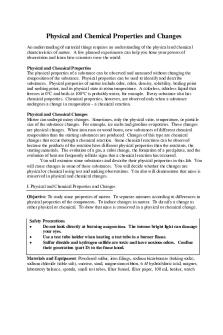Physical Properties of Borosilicate Glass PDF

| Title | Physical Properties of Borosilicate Glass |
|---|---|
| Course | Biology |
| Institution | Universiti Utara Malaysia |
| Pages | 3 |
| File Size | 89 KB |
| File Type | |
| Total Downloads | 20 |
| Total Views | 168 |
Summary
Lab Work Borosilicate Glass...
Description
Physical Properties of Borosilicate Glass 3.3 Borosilicate glass 3.3 differs from other materials used in construction not only because of its virtually universal resistance to Mean linear thermal expansion coefficient
a 20/300
=
(3,3 ± 0,1) x 10-6 K-1
Mean thermal conductivity between 20 and 200°C
l 20/200
=
1,2 W m-1 K-1
Mean specific heat capacity between 20 and 100°C
Cp 20/100
=
0,8 kJ kg-1 K-1
Mean specific heat capacity between 20 and 200°C
Cp 20/200
=
0,9 kJ kg-1 K-1
=
2,23 kg dm-³
Density at 20°C
The common type of borosilicate glass used for laboratory glassware has a very low thermal expansion coefficient (3.3 × 10−6 K−1),[3] about one-third that of ordinary soda-lime glass. This reduces material stresses caused by temperature gradients, which makes borosilicate a more suitable type of glass for certain applications (see below). Borosilicate glass is a lowcost compromise. While more resistant to thermal shock than other types of glass, borosilicate glass can still crack or shatter when subjected to rapid or uneven temperature variations. Among the characteristic properties of this glass family are:
Different borosilicat glasses cover a wide range of different thermal expansions enabeling direct seals with various metals and alloys like [molybdum] glass with a CTE of 4,6, tungsten with a CTE around 4,0 and Kovar with a CTE around 5,0 because of the matched CTE with the sealing partner
Allowing high maximum temperatures of typically about 500 °C
Showing an extremely high chemical resistance in corrosive environments. Norm tests for example for acid resistancecreate extrem conditions and reveal very low impacts on glass
The softening point (temperature at which viscosity is approximately 107.6 poise) of type 7740 Pyrex is 820 °C (1,510 °F).[4] Borosilicate glass is less dense (about 2.23 g/cm3) than typical soda-lime glass due to the low atomic mass of boron. The temperature differential that borosilicate glass can withstand before fracturing is about 165 °C (329 °F). This compares well with soda lime glass, which can withstand only a 37 °C (99 °F) change in temperature and is why typical kitchenware made from traditional sodalime glass will shatter if a vessel containing boiling water is placed on ice, but Pyrex or other borosilicate glass laboratory will not.[5] Optically, borosilicate glasses are crown glasses with low dispersion (Abbe numbers around 65) and relatively low refractive indices (1.51–1.54 across the visible range).
Borosilicate glass is a type of glass with silica and boron trioxide as the main glass-forming constituents. Borosilicate glasses are known for having very lowcoefficients of thermal expansion (~3 × 10−6 K−1 at 20 °C), making them resistant tothermal shock, more so than any other common glass. Such glass is less subject tothermal stress and is commonly used for the construction of reagent bottles. Borosilicate glass is sold under such trade names as Borcam, Borosil, DURAN, Suprax, Simax, BSA 60, BSC 51 (By NIPRO), Heatex, Endural, Schott, Refmex,Kimble, and some (but not all) items sold under the trade name Pyrex. Coeff. of Exp.
32.5 x 10-7cm/cm/°C
Strain Point
510°C
Anneal Point
560°C
Soften Point
821°C
Density
2.23 g/cm3
Youngs Mod.
6.4 x 103 Kg/mm2
Refract. Index
1.474 @ Sodium D Line
Temp. Limits Max. Thermal Shock
490°C (Extreme Service) 230°C (Normal Service) 160°C
Physical properties of borosilicate glass Borosilicate glass is a type of glass which compromise of silica and boron trioxide as the main components. Below are some of the physical properties of borosilicate glass;
It has a very low thermal expansion coefficient
−6 −1 ~ 3 × 10 K at 20 °C Resists thermal shock due to changes of temperature. Thus, no need of extreme measures to compensate thermal expansion. Reduces thermal stresses and is commonly used as the reagent bottles....
Similar Free PDFs

physical properties of food quiz
- 1 Pages

Physical properties table
- 32 Pages

physical properties lab report
- 10 Pages
Popular Institutions
- Tinajero National High School - Annex
- Politeknik Caltex Riau
- Yokohama City University
- SGT University
- University of Al-Qadisiyah
- Divine Word College of Vigan
- Techniek College Rotterdam
- Universidade de Santiago
- Universiti Teknologi MARA Cawangan Johor Kampus Pasir Gudang
- Poltekkes Kemenkes Yogyakarta
- Baguio City National High School
- Colegio san marcos
- preparatoria uno
- Centro de Bachillerato Tecnológico Industrial y de Servicios No. 107
- Dalian Maritime University
- Quang Trung Secondary School
- Colegio Tecnológico en Informática
- Corporación Regional de Educación Superior
- Grupo CEDVA
- Dar Al Uloom University
- Centro de Estudios Preuniversitarios de la Universidad Nacional de Ingeniería
- 上智大学
- Aakash International School, Nuna Majara
- San Felipe Neri Catholic School
- Kang Chiao International School - New Taipei City
- Misamis Occidental National High School
- Institución Educativa Escuela Normal Juan Ladrilleros
- Kolehiyo ng Pantukan
- Batanes State College
- Instituto Continental
- Sekolah Menengah Kejuruan Kesehatan Kaltara (Tarakan)
- Colegio de La Inmaculada Concepcion - Cebu












